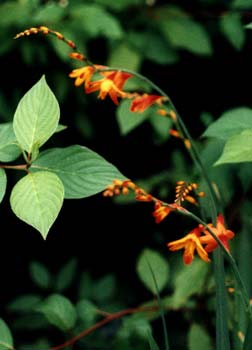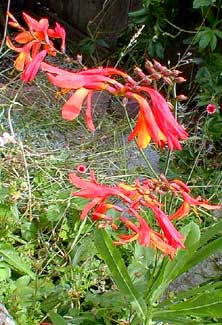
'Emily Mckenzie' Crocosmia
Crocosmia x crocosmiiflora 'Emily Mckenzie' looks like a flame in deepest hues of orange & vibrant yellow-orange. It's shown in the first photo in an August portrait against leaves of a Redtwig Dogwood.
The best specimens have a mahagony-red mark deep in the throat, but as its seedlings often have only more red in the throat we more often see them without so dark a heart. The best specimens with the darkest throats are obtained by growing them from offset cormlets, not from seed.
It was discovered in 1951 by a certain Emily Mckenzie in her garden in the Tyne Valley in England. It is by some believed to have been a natural sport of an older hybrid called 'Comet' (aka 'Malahide Castle' after the Malahide Castle Gardens in county Dublin) which was developed by crossing C. aurea with C. masoniorum. But 'Emily Mckenzie' may also have C. pottsii in its make-up as do the majority of today's Crocosmia hybrids.
The lances of 'Emily McKenzie' foliage are more compact than on some crocosmia cultivars, such as a taller variety in our gardens called 'Lucifer.' Its flowers are also bigger than for 'Lucifer.' The flowers are just about scentless; the name Crocosmia means "Scent of Crocus" because the leaves when rubbed smell of saffron.
 Crocosmia spreads into quite a stand of fronds, & can be dug up every three or four years to separate for propagation purposes, when you will find many cormels (tiny corms) attached to the main corms.
Crocosmia spreads into quite a stand of fronds, & can be dug up every three or four years to separate for propagation purposes, when you will find many cormels (tiny corms) attached to the main corms.If not deadheaded or cut for bouquets, it will self-seed. The second photo is a bloom from a very young plant that sprang up unexpectedly a considerable distance from the parent. It is not quite the same color as the original 'Emily Mckenzie.'
The ability of crocosmia to self-seed has rendered it a troublesome invasive in some parts of the world, though the newest hybrids are not as apt to be problems. In our temperate climate, this South African native is restrained.
As cut flowers these will last two full weeks in a vase. Buds open one after another starting from the bottom & working up. The bottom-most flowers drop off tidily as they are spent. Taking the blooms for arrangements induces further blooming all summer, from July to first frost in autumn. If summer gets too droughty or if summer blooms are permitted to go to seed, it will die back sooner. Leaves should not be trimmed until they are definitely dying back.
Crocosmia does not like extremely cold regions, & needs winter mulching wherever temperatures drop below about 20 degrees F. 'Emily Mckenzie' is best for zones seven through nine, but with careful winter mulching can be grown down to zone 5. It will need to be lifted & stored until spring in places that fall to zero degrees F., or grown in containers that can be brought to shelter for winter.
It's ideal is a climate with warm & occasionally humid summers, but it is very adaptable to temperate zones such as here on Puget Sound. It should be placed in full sun in moist well-draining soil, but I've also seen it doing fairly well in dry bright shade, though it does not get as big & flowery.